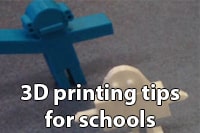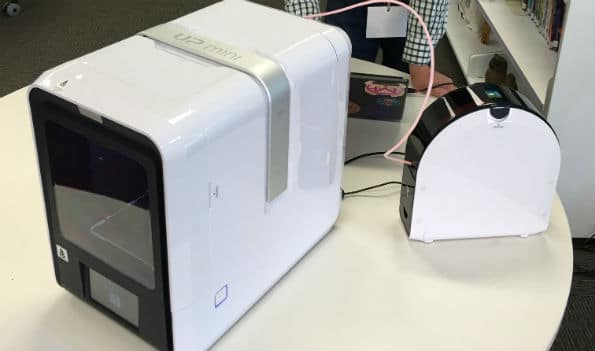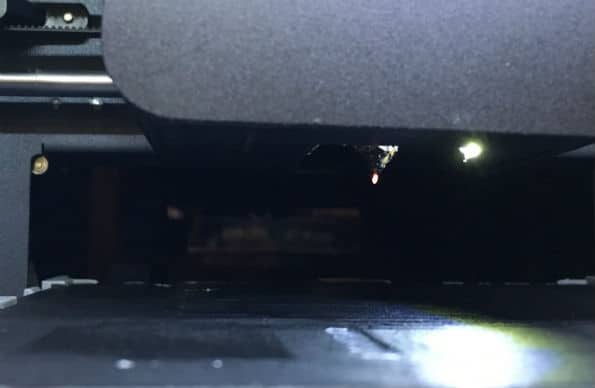
Get creative!
3D printing offers so much for students and educators to explore design! The technology has exploded across schools as the barriers to entry have dropped; it is becoming quite common to see a 3D printer in high schools and the trend is spreading to primary schools as teachers create maker spaces in their classrooms. Still, as with any technology, there is always a learning curve and as such, it is helpful to know the variety of factors that are worth considering.
3D printing safety
In a school environment, you have to make sure that your 3D printing is done safely. The following lists some simple tips to be aware of whilst setting up 3D printing in your classroom:
Is there a guard to prevent students from touching the extruder whilst 3D printing is taking place?
In order to be able to make your 3D print, the extruder needs to be hot to be functional and you don’t need your kids touching this! The good news is that you can buy 3D printers that have safety guards that enclose the printing area plus you there are also printer models that will stop extruding filament if the enclosed area is opened.

UP Mini 3D printer
Can you contain the fumes?
An early issue for educators was that the fumes from 3D printing could be quite strong. Apart from simply opening windows & doors to vent your workspace, the good news is that now you can get 3D printers with air filters. You can also choose to use to print using PLA filament instead of ABS. Both of these materials are thermoplastics however the PLA (Polylactic Acid) is a carbohydrate-based material derived from corn, potatoes or even beetroot whereas ABS is an oil-based polymer. This means that printing in PLA has a smell akin to heating cooking oil whereas ABS has the industrial smell of heating plastics. We recommend that you print in PLA in a school environment where possible as part of discussions on sustainability.
3D print quality
How you use the 3D printer can have a dramatic impact on your 3D print quality.
Get your printer bed level flat
This might seem obvious but this makes a difference! If your printer is at an angle you risk warped designs as well as putting unnecessary stress on the machine.

3D printed balloon dog on its way!
The extrusion temperature is important
If your extruder is set either too hot or too cold for the filament you’re using you’re effectively operating outside of the optimal printing conditions that the printing filament was designed for. Check your manufacturing guidelines and run some tests a couple of degrees either side of the optimal level to see the difference (variable testing!). You’ll need to ensure that the first layer of print is hotter than the rest of the print so as to ensure good adhesion of the print to the printer bed. If your extruder is too hot you’ll get more strings of melted filament from the nozzle and this could even lead to constant leaking of the filament onto your design. If your extruder is too cold you could find that the printed layers just don’t stick together very well and you’ll find that you need to unclog the nozzle often.

Extruded filament drying on a 3D printer extruder nozzle
Printer bed heating needs to be considered
Ideally, you need to make sure that the printer bed is heated to the optimal temperature needed to get your 3D prints to stick. If the printer be is too cold you might find that the print won’t adhere properly whereas if the printer bed is too hot the print will be too soft at the point of contact which risks it being peeled off the bed by any filament still stick to the extruder nozzle.
Don’t forget the extruder height from the bed!Your melted filament can cool slightly before it reaches the printer bed and stop your print adhering the bed properly.

Setting the nozzle height on a 3D printer
Storage
Simply, where are you intending on using the 3D printer? What about the filament itself? Aim to keep the filament stored away from moisture; long-term exposure to humid environments will lead to a problem in printing from in terms of clogging the nozzle, print discolouration and weakening of the print itself. Some people have been using food dehydrators to treat the filament but know that this can change the crystalline structure of the PLA filament.
As you can see, there a few factors to consider when 3D printing but they are by no means insurmountable. All it takes is a bit of trial and error and your students will be creating all manner of awesome objects! It’s a lot of fun and your students might discover some talents they didn’t know they had!
Want to give 3D printing a trial? We’re working with Makers Empire to deliver primary school incursion workshops on 3D printing which help students get their head around computer-aided design. An easy way for your school to dip into this technology and learn along the way.
Happy teaching,
NEW Primary science teaching book!
“Be Amazing! How to teach science, the way primary kids love”



























Comments